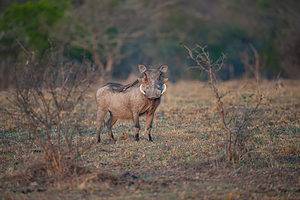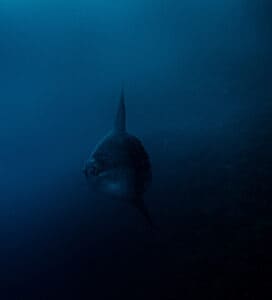The biggest animals on the planet are water animals! Without the same resistance of gravity, water animals are able to get much larger and heavier than land animals. Elephants, the biggest land animal, are big, don’t get me wrong, but when you compare an elephant to a blue whale they pale in comparison. The biggest blue whale ever recorded was 418,878 pounds (190 tons) which is equivalent to about 30 elephants! An average blue whale weighs closer to 242,500 pounds but that is still the biggest water animal on Earth.
When comparing types of water animals we wanted to look at a variety of species to make things interesting, so we will be comparing the average weight of several types of animals. So while not all whales are bigger than all sharks, the leader in each category has the heaviest average weight in comparison. Let’s dive in to the 15 biggest types of water animals!
1) Whales (Blue Whale: 242,500 pounds)
Whales are the biggest water animals on Earth! The top 9 biggest water animals are whales with the blue whale topping the list! Blue whales average around 242,500 pounds but can get up to 400,000 pounds or more! When it comes to length they are some of the longest as well with the record longest blue whale measuring 110 feet 17 inches being measured at a South Georgia whaling station more than a hundred years ago (1909). Blue whales also have the biggest babies with newborns being born in the 5,000-6,000 pound range! Yikes!
Make a note that whales are in the Cetacean family and include whales, dolphins (which include killer whales), porpoise, beluga and narwhal. Here are the top 10 biggest whales:
- Blue whale: 242,500 pounds
- Right whale: 132,300 pounds
- Fin whale: 125,700 pounds
- Bowhead whale: 122,200 pounds
- Sperm whale: 68,900 pounds
- Humpback: 63,900 pounds
- Sei whale: 49,600 pounds
- Gray whale: 43,000 pounds
- Bryde’s whale: 42,000 pounds
- Killer whale (orca): 12,000 pounds
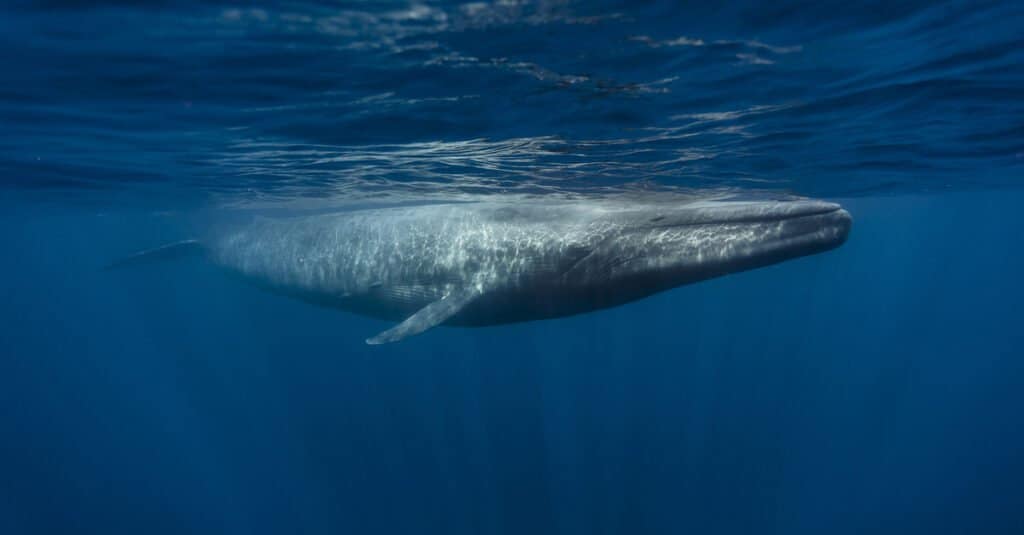
Blue whales average around 242,500 pounds but can get up to 400,000 pounds or more!
©Andrew Sutton/Shutterstock.com
2) Sharks (Whale Shark: 41,000 pounds)
Now onto some sharks! The biggest shark in the world is the whale shark. Sharks are fish so that makes the whale shark the biggest fish in the world as well! Whale sharks average around 41,000 pounds but according to the NOAA it is estimated they can get up to 80,000 pounds (40 tons). They have some of the biggest mouths with a “smile” that is 4 feet wide. Whale sharks are gentle giants and float slowly through their world with their mouths open, sifting the water for zooplankton, krill and small fish.
Basking sharks, another big shark, feed in the same way but you have to compare the mouths of both, a photo does the best justice. Both enormous sharks that seem scary but aren’t. There are certainly some sharks you don’t want to run into in the open ocean or anywhere, and here is the list of the biggest sharks in the sea:
- Whale shark: 41,000 pounds
- Basking shark: 10,200 pounds
- Megamouth shark: 2,600 pounds
- Greenland shark: 2,200 pounds
- Great white shark: 2,000 pounds
- Tiger shark: 1,125 pounds
- Bluntnose sixgill shark: 800 pounds
- Pacific sleeper shark: 750 pounds
- Thresher shark: 510 pounds
- Great hammerhead shark: 500 pounds
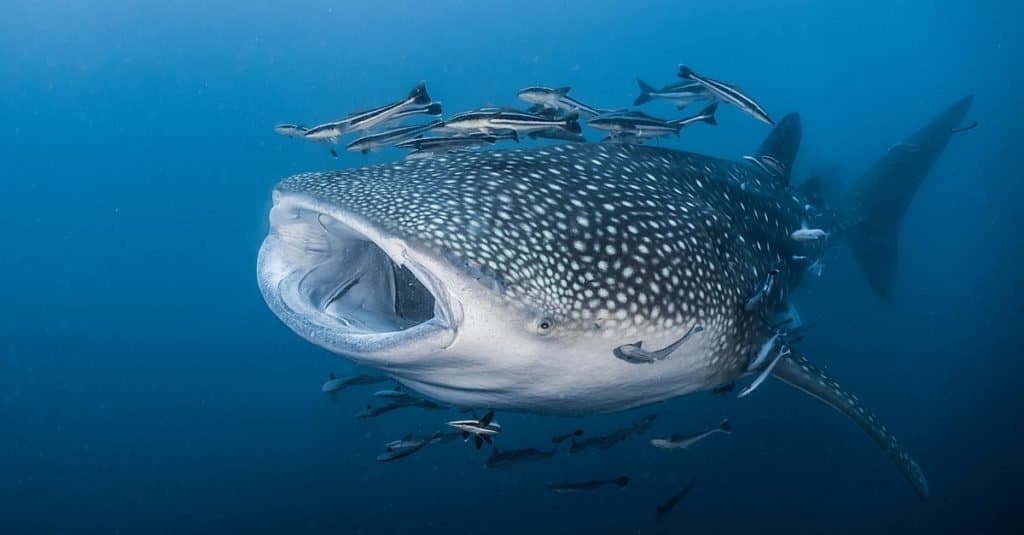
The whale shark has a 4 feet wide mouth and weighs on average around 41,000 pounds.
©Onusa Putapitak/Shutterstock.com
3) Rays (Giant Oceanic Manta Ray: 4,400 pounds)
Rays are a pancake-flat fish with a long skinny tail that has a barb at the end that is usually venomous. They don’t have bones but are made of cartilage like sharks. This may be hard to wrap your brain around but the giant oceanic manta ray can have a “wing” span of 29 feet! I’m having a hard time grasping the magnitude of that sitting in my 12 x 12 office! Think about just how big that is! Although giant manta rays average 4,000+ pounds they live off of massive amounts of zooplankton. There are a variety of rays, stingrays and skates that can get to be quite large. Here are the biggest rays in the sea:
- Giant Oceanic Manta Ray: 4,400 pounds
- Reef Manta Ray: 3,100 pounds
- Giant Devil Ray: 2,000 pounds
- Deepwater Stingray: 260 pounds
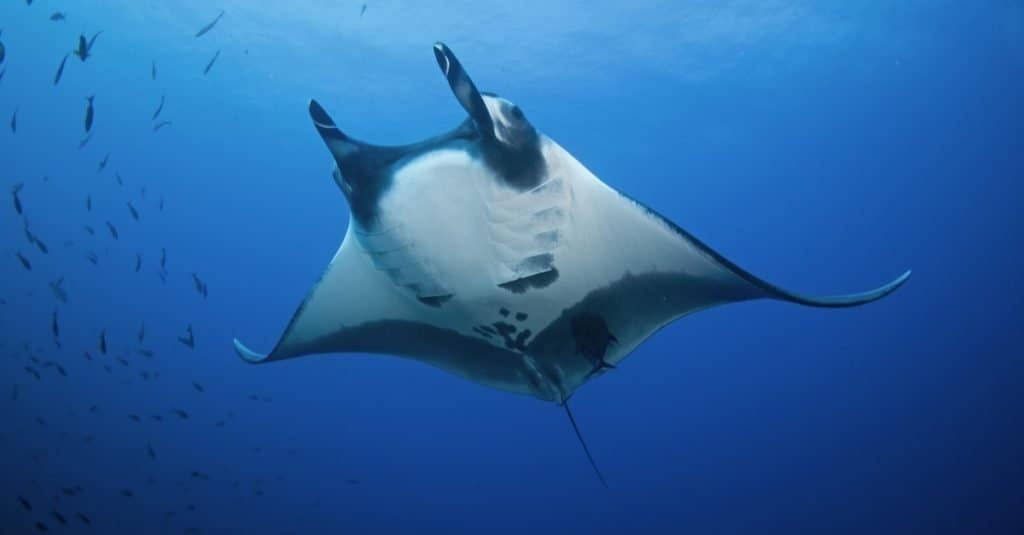
The giant oceanic manta ray can have a “wing” span of 29 feet!
©Martin Prochazkacz/Shutterstock.com
4) Ocean Sunfish/Mola Mola (Hoodwinker Sunfish/Sharptail Mola: 4,000 pounds)
You may be familiar with ocean sunfish that are also called mola mola but if it is the first time seeing this fish you may be a bit surprised! What exactly is going on with these mega fish with massive bodies two weirdly shaped fins and a face only a mother can love? They are also missing a dorsal fin so they just look…odd. Ocean sunfish are huge and while the average are 4,000 pounds, the largest ones can get to be 5,000 pounds or more. Lengthwise they can get to be 10 feet long! That would nearly fill my office!
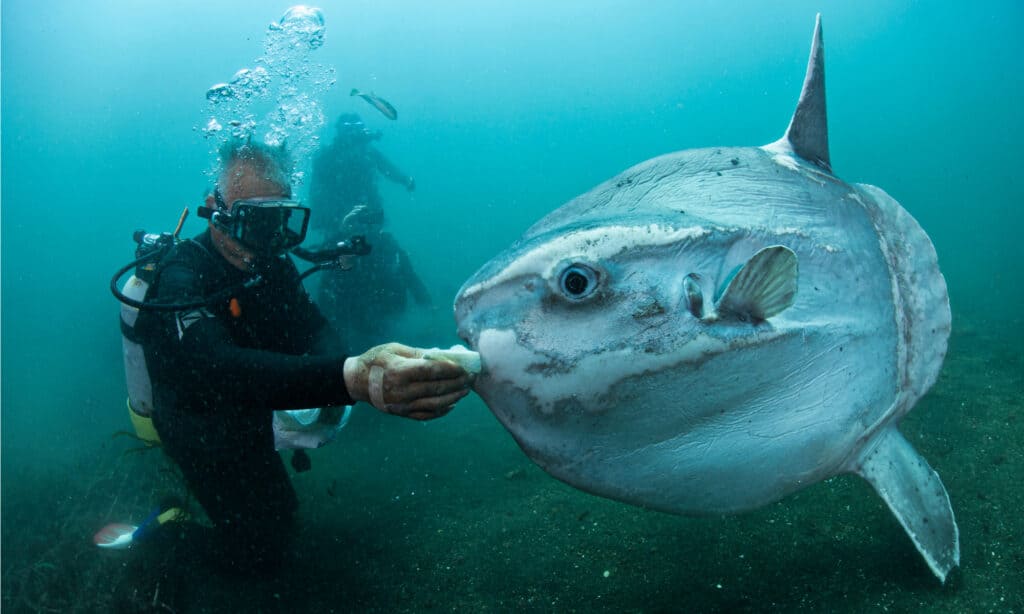
Ocean sunfish on average weigh 4,000 pounds and can grow to 10 feet in length.
©Martin Voeller/Shutterstock.com
5) Sturgeon (Beluga Sturgeon: 2,200 pounds)
Sturgeon are often referred to as fossil fish due to their similar characteristics to fish 200 million years ago! Their backs are covered in scutes like armor plating and their long torpedo-shaped bodies look dinosaur-like. Many sturgeon are anadromous meaning they hatch in freshwater streams and rivers, then migrate out to the ocean and then return to the same river or stream to spawn again. The beluga sturgeon can be found in the Caspian Sea in countries like Russia, Kazakhstan, and Iran. In fact the biggest sturgeon ever caught was a beluga sturgeon that weighed 3,463 pounds, captured in 1827 on the Volga Delta, between Russia and Kazakhstan.
White sturgeon are the biggest sturgeon in North America, one of eight different sturgeon species that live in the US. Sturgeon are not only heavy but really long! The longest recorded white sturgeon was 20 feet long but most are closer to 6 ½ feet. Other sturgeon species that can be found in North America are Green Sturgeon, Lake Sturgeon and Atlantic Sturgeon.
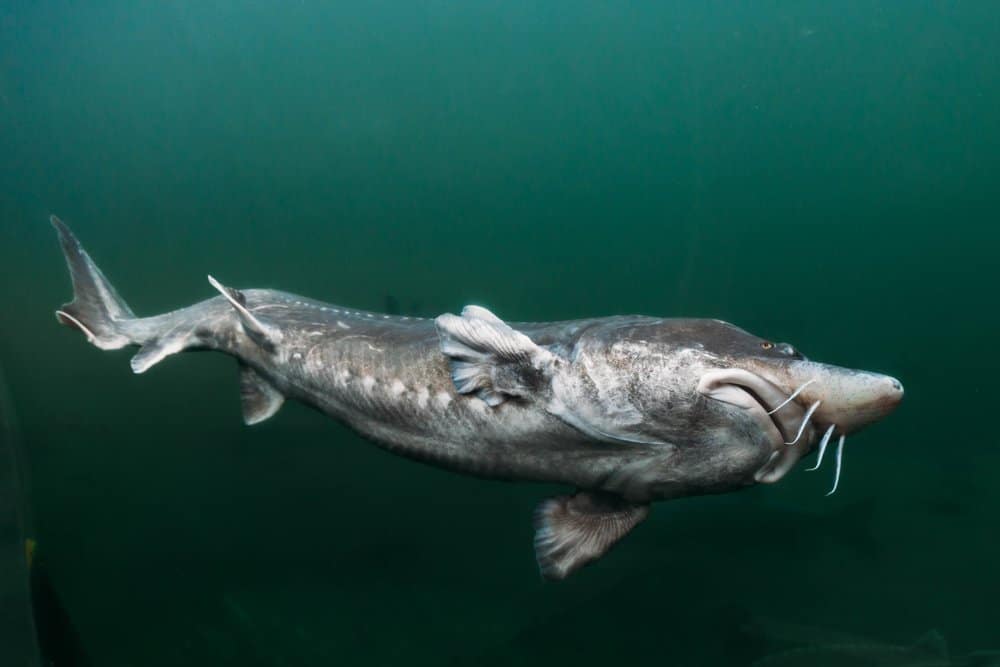
The biggest sturgeon ever caught was a beluga sturgeon that weighed 3,463 pounds, captured in 1827.
©Olga Alper/Shutterstock.com
6) Squid (Colossal Squid: 1,090 pounds)
Squid are a water animal that are super heavy and really long, with tentacles that dangle behind at impressive lengths. The largest squid species is rightfully named the colossal squid. Colossal squid weigh an average of 1,090 pounds and can have tentacles that are 32 feet long! They live in the deep (very deep) cool waters of Antarctica at depths of 1,000 feet or more. Because they live at such depths and in Antarctica there are limited studies on these fascinating creatures. They have a leaf-like tip with a bulbous head with a giant eye on either side. They have eight arms, similar to an octopus, plus two longer feeding tentacles.
Giant squid are another noteworthy squid with a few differences between the giant and colossal. Their average weight is less than the colossal squid but their tentacles typically reach longer. Giant squid have a more elongated body than the bulkier colossal squid. While colossal squid are only found in and around the waters of Antarctica, giant squid can be found in a larger range including the Atlantic and Pacific Oceans.
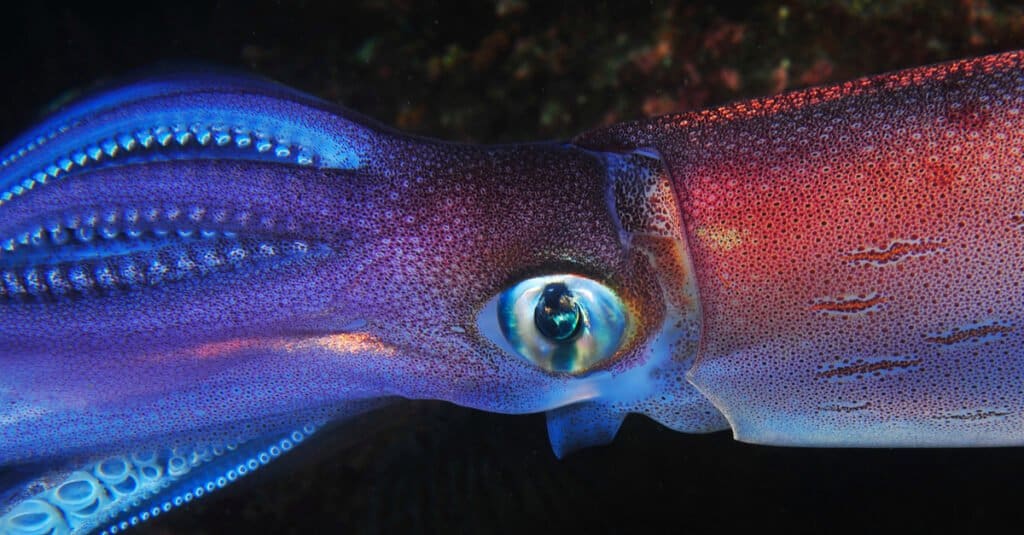
The largest squid species is the colossal squid weighing an average of 1,090 pounds, with tentacles that can reach 32 feet in length!
©Rui Palma/Shutterstock.com
7) Manatee/Dugong (West African Manatee: 1,000 pounds/Dugong: 930 pounds)
Manatee and dugong are similar marine mammals with a heavy set body and smaller paddle-like pectoral flippers. Manatee are larger than dugong and have a rounded paddle tail whereas dugong have a whale-like tail. West African manatee average around 1,000 pounds and are sometimes called sea cows since they slowly make their way along the bottom of the ocean munching on seaweed as they go. Some of the largest manatee and dugong include:
- West African Manatee: 1,000 pounds
- West Indian Manatee: 990 pounds
- Dugong: 930 pounds
- Amazonian Manatee: 920 pounds
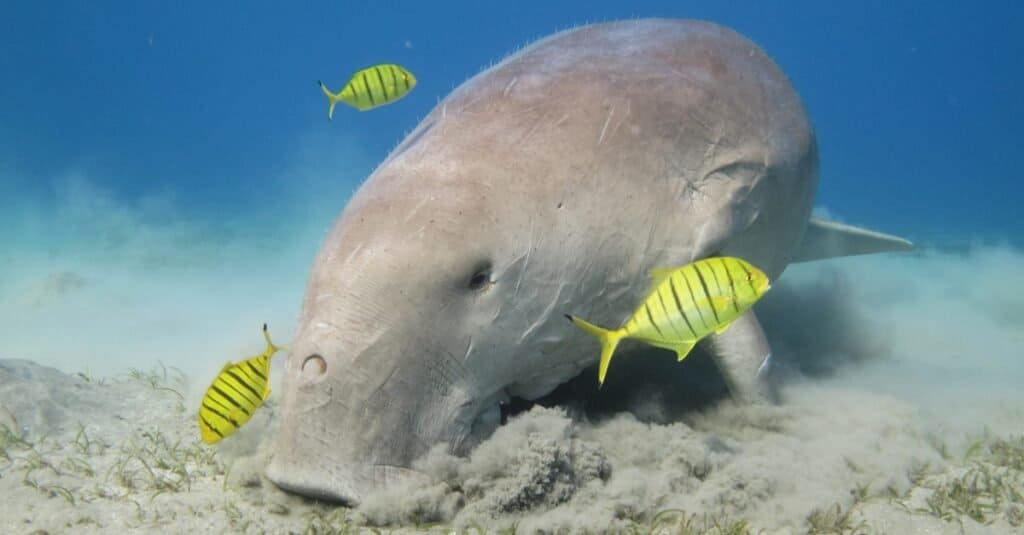
Dugong are similar marine mammals to the manatee but slightly smaller, reaching an average weight of 930 pounds.
©Laura Dts/Shutterstock.com
8) Grouper (Goliath Grouper: 800 pounds)
Grouper is a large sea dwelling fish with an enormous upturned mouth and massive body. They can get to be 8 feet long and weigh 800 pounds! The goliath grouper is the largest of the Atlantic groupers and can be found in the Atlantic Ocean near shore around coral reefs. They also prefer the waters in the Gulf of Mexico and around the Florida Keys. They can be found along the coast line with some even being caught as far north as Maine. According to the International Game Fish Association, the largest recorded goliath grouper was caught off Fernandina Beach, FL which is NE of Jacksonville, near the Florida/Georgia border. This record catch dates back to May 20, 1961, when Lynn Joyner caught a goliath grouper that weighed 680 pounds!
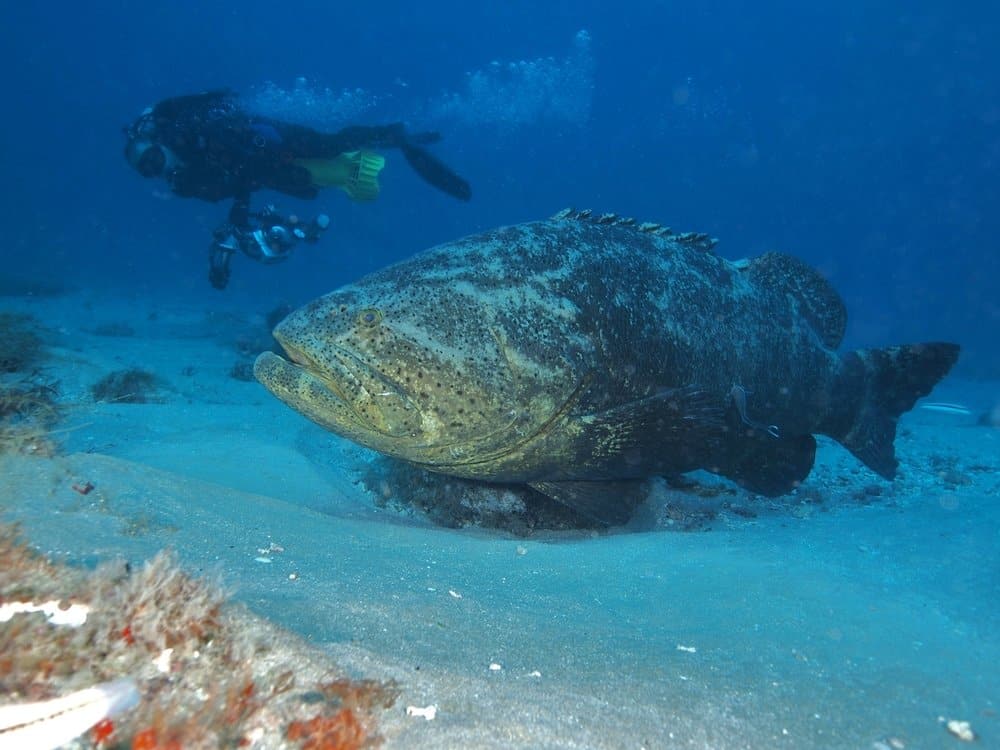
The goliath grouper is the largest of the Atlantic groupers growing up to 8 feet in length and weighing up to 800 pounds!
©Jonathan Churchill/Shutterstock.com
9) Sea Turtles (Leatherback Sea Turtle: 800 pounds)
If you have ever seen a sea turtle in person or at an aquarium you knew they would show up on this list at some point! For the hard-shelled sea turtles you may wonder why they don’t sink to the bottom of the sea with such a large shell! Sea turtles are well suited for the sea with large front flippers that help them swim easily and often for long distances. The females come on shore to lay their eggs, digging a nest in the sand, laying her eggs and then returning out to sea. Once the baby sea turtles hatch they make a massive byline for the ocean.
Leatherback sea turtles are the largest of the sea turtles with an average size of around 800 pounds, but some can get more than 1,000 pounds. Here are some of the largest sea turtles:
- Leatherback: 800 pounds
- Loggerhead: 300 pounds
- Green: 250 pounds
- Australian Flatback: 200 pounds
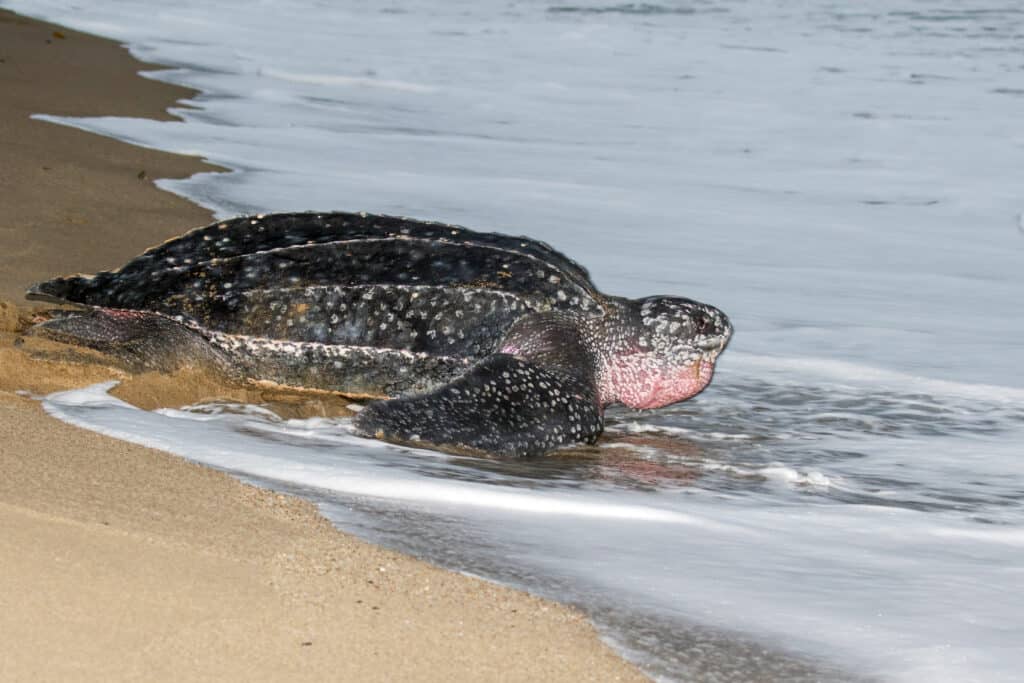
Leatherback sea turtles are the largest of the sea turtles with an average size of around 800 pounds.
©iStock.com/AGAMI stock
10) Marlin (Blue Marlin: 770 pounds)
Marlin are not only some of the biggest fish but they are also some of the fastest water animals. Sailfish, marlins and swordfish are all commonly put at the top of the “fastest fish” list with sailfish reaching speeds of 70 mph! Blue marlins average around 770 pounds and can get to be 12 feet long. They have a long sword-like snout and fanned dorsal fin that juts up then tapers off. Blue marlin have a brilliant blue dorsal side and silver to gray belly. Blue marlins live in the Pacific, Atlantic and Indian Ocean in both tropical and subtropical waters. Another type of marlin is the black marlin which are a tad smaller than blue marlin but a tad faster as well.
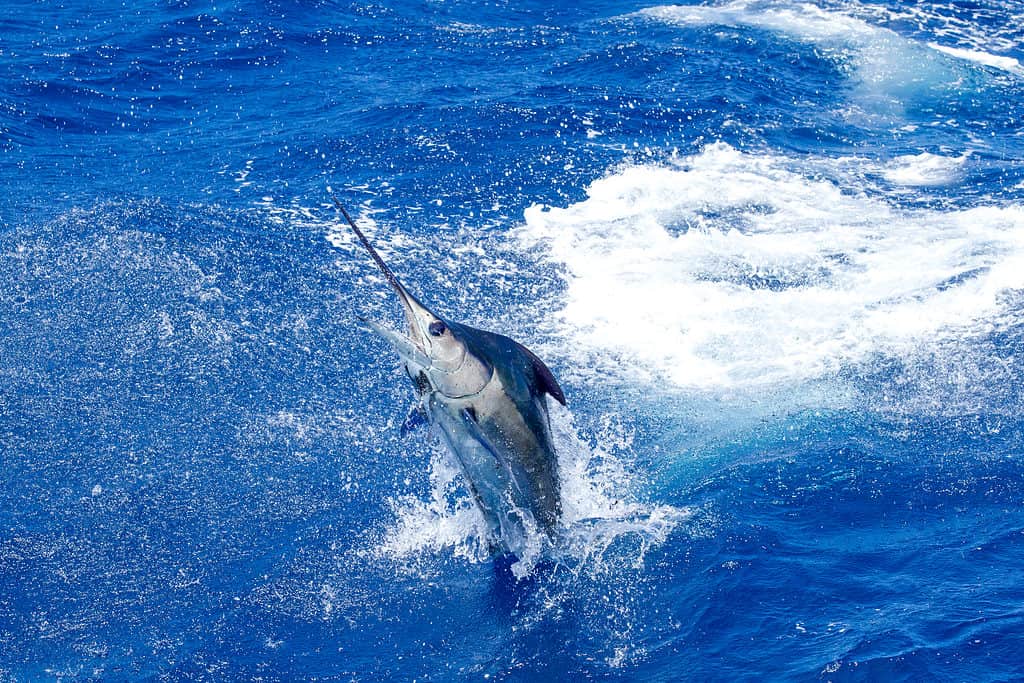
Blue marlins average around 770 pounds in size and can get to be 12 feet long.
©kelldallfall/Shutterstock.com
11) Sawfish (Sawfish: 700 pounds)
Sawfish look similar to marlins and swordfish but they are not billfish. Instead they are related to sharks and are in the Rajiformes order like skates and rays. They look like a mix of a shark/stingray/swordfish with features of each. Their long tooth-edge snout is what you may notice first, almost like a rounded chainsaw lined with sharp teeth. They use this as a tool to slice prey and also to dig through the sand to look for prey. Sawfish average around 700 pounds and can get to be 25 feet long! Off the coast of the US you can find two kinds of sawfish, largetooth sawfish and smalltooth sawfish.
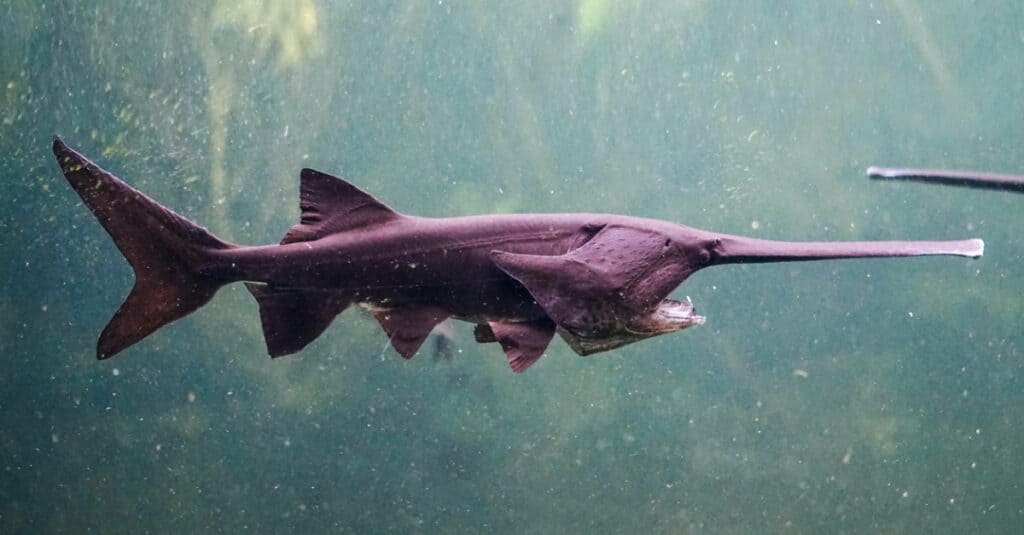
Sawfish average around 700 pounds in size and can grow up to 25 feet in length.
©PX Media/Shutterstock.com
12) Tuna (Bluefin Tuna: 525 pounds)
If you have ever watched the popular show Wicked Tuna you know how enormous bluefin tuna can get! They are also not going to just give up and let you reel them in. Bluefin tuna average around 525 pounds but the largest ever recorded weighed 1,496 pounds! Ken Fraser’s record breaker has stood the test of time since 1979. He caught his bluefin tuna while fishing off the coast of Nova Scotia, Canada. Here are some of the most common tuna species:
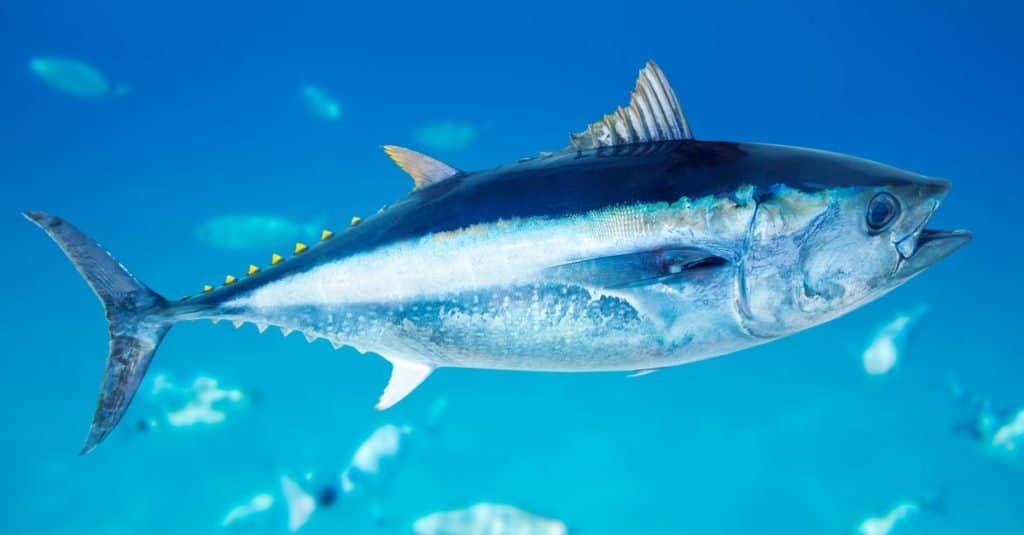
Bluefin tuna average around 525 pounds, but the largest ever recorded weighed 1,496 pounds!
©lunamarina/Shutterstock.com
13) Mekong Giant Catfish (Mekong Giant Catfish: 440 pounds)
Another freshwater fish on our list is the Mekong Giant Catfish! They look like your common channel catfish but super sized! Mekong giant catfish average around 440 pounds but the largest one ever caught tipped the scales at 646 pounds. It was caught in the Mekong River, the longest river in southeast Asia, and measured 9 feet long. The three most common catfish in the US are the blue catfish, flathead and channel cat with the blue being the largest followed by the flathead and channel.
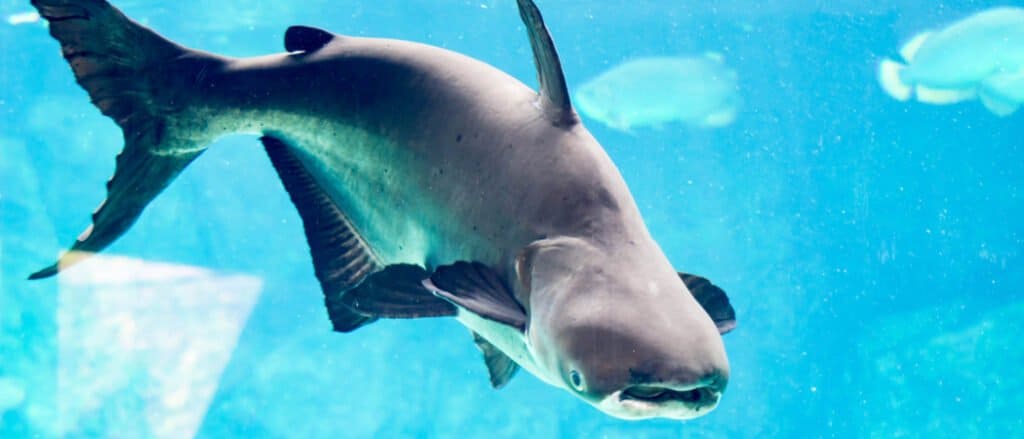
Mekong giant catfish average around 440 pounds in size with the largest ever caught weighing 646 pounds.
©Bill Roque/Shutterstock.com
14) Arapaima (Arapaima: 440 pounds)
Arapaima are tropical freshwater fish found in South America, living in the Amazon River Basin. They have long heavily scaled bodies and an upturned mouth. They are surprisingly able to breathe air and can live out of water for up to 24 hours, however they spend most of their time in the rivers and tributaries, searching for food. This ability to process oxygen from the air allows them to thrive in oxygen-deprived waters that other fish are not capable of. Arapaima can be 440 pounds and some have been recorded at 10 feet long. Other massive fish that live in the Amazon River Basin include Tambaqui and Piraíba.
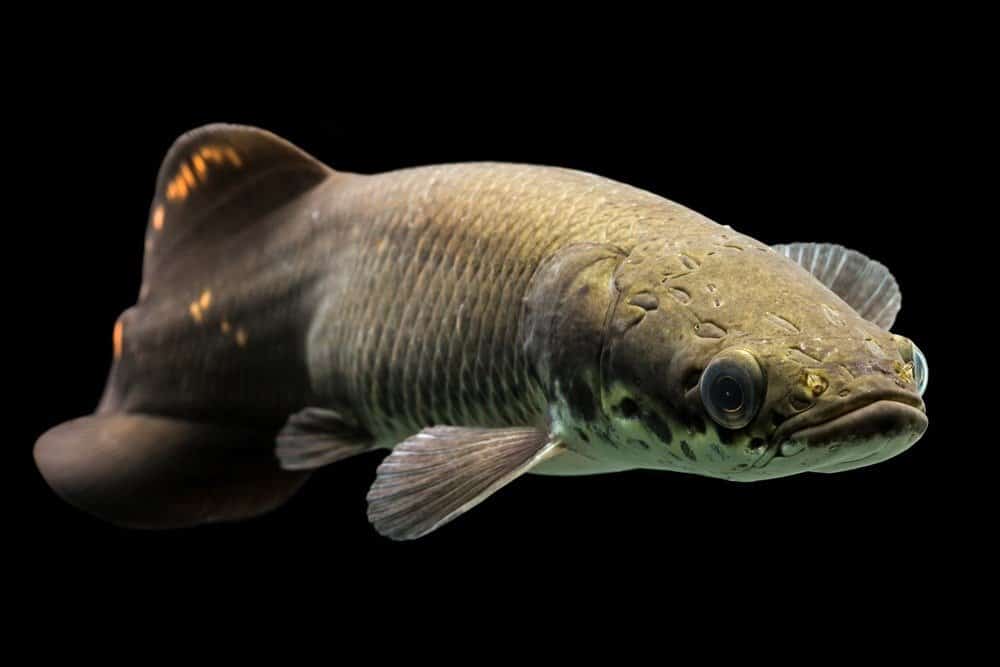
Arapaima are 440 pounds on average and have the ability to process oxygen from the air.
©Ammit Jack/Shutterstock.com
15) Giant Clam (Giant Clam: 400 pounds)
Is a clam an animal? Yes! The giant clam is a bivalve mollusk that is a filter feeder, similar to baleen whales that filters the water for food. Giant clams sit at the bottom of the sea and have a symbiotic relationship with algae. The algae’s waste is a nutrient that helps feed giant clams, contributing to their overall weight. A full grown giant clam can weigh 400-500 pounds and reach a length of 4 feet, that’s about as wide as your average kitchen table! They can be found in both the Indian Ocean and South Pacific Ocean, usually mixed in with coral reefs. Their unique coloration makes them a favorite for divers and although tales warn of giant clams swallowing divers, these are myths. Giant clams are harmless to humans.
This list gives you and overview of some of the biggest types of water animals, but there are quite a few that fall in the 200-400 pound range. Take a minute to explore more about the Dall’s porpoise, bottlenose dolphin, swordfish, giant oarfish, sailfish and lion’s mane jelly fish (which can have tentacles that are 100 feet long!).
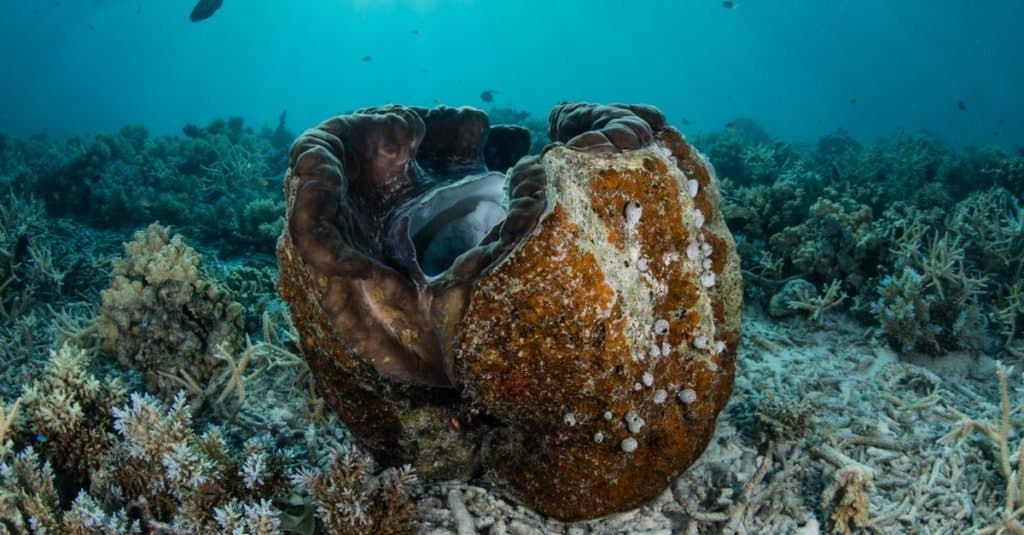
A full grown giant clam can weigh 400-500 pounds and reach a length of 4 feet.
©Ethan Daniels/Shutterstock.com
The photo featured at the top of this post is © Craig Lambert Photography/Shutterstock.com
Thank you for reading! Have some feedback for us? Contact the AZ Animals editorial team.



